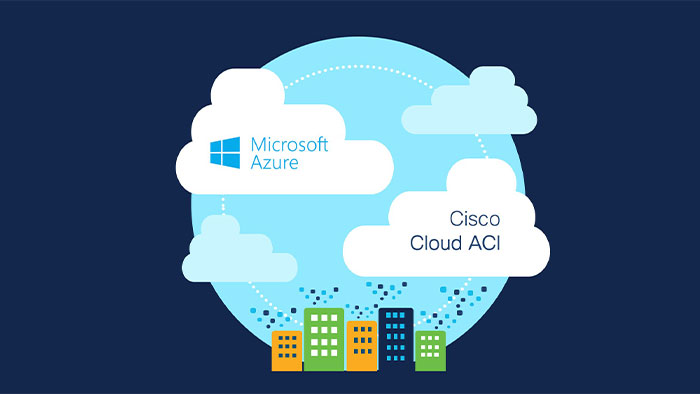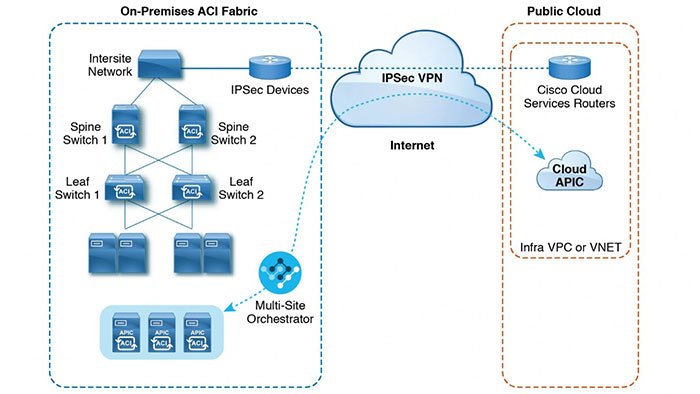
Customers with a private cloud sometimes may run part of their workload on a public cloud. However, migrating the workload to the public cloud requires working with a different interface and learning different ways to set up connectivity in to find security policies. Meeting these challenges can result in an increased operational cost and loss of consistency.
Cisco cloud APIC is a software component of Cisco ACI that can be deployed on a cloud-based virtual machine. Cisco cloud APIC is a key part of Cisco ACI extension to the public cloud and provides consistent policy, security and analytics. Cisco cloud APIC offers the following features:
An interface that’s similar to the existing Cisco APIC to interact with Amazon Web Services or Microsoft Azure public cloud. it automates the deployment and configuration of cloud connectivity, configures the control plane for the cloud routers, translates Cisco ACI policy to cloud native policies and it discovers endpoints and dynamically assigns them to a user-defined endpoint groups. It configures the data path between the on-premises Cisco ACI fabric and the cloud site for on-premises to cloud connectivity configurations, plus, it configures cloud site to cloud site connectivity.
As part of the initial release of the Cisco cloud APIC in release 4.11 support was provided for on-premises to cloud connectivity or hybrid cloud where you could use the cisco ACI multi-site Orchestrator to extend an on-premise Cisco ACI site to AWS of the clouds. beginning in release 4.21 you can now use cisco ACI multi-site Orchestrator to extend an on-premises Cisco ACI site to Microsoft azure public clouds. You can use the Cisco ACI multi-site Orchestrator to establish connectivity in several ways.
You can have connectivity between an on-premises site to a single cloud site which is known as hybrid cloud. Moreover, you can have connectivity between on-premises site to multiple cloud sites, which is known as hybrid multi-cloud. For both of these types of connectivity the cloud site can be either Microsoft Azure or AWS public cloud sites. You can also use the Cisco ACI a multi-site Orchestrator to establish connectivity between multiple cloud sites without an on-premises site this is known as multi-cloud. These connections can be between multiple AWS public cloud sites, between multiple Microsoft Azure public cloud sites or between a mixture of AWS and Microsoft Azure public cloud sites. Lastly, support is also available for a single cloud configuration or cloud first.

When configuring on-premise to cloud connectivity several components each with its specific role are required to extend the Cisco ACI a multi-site fabric to the AWS or Microsoft Azure public clouds. Note that MSO can be placed either on the on-premises site or the public cloud site.
Cisco ACI allows application requirements to define the network this architecture, simplifies, optimizes and accelerates the entire application deployment lifecycle. Cisco APIC is a key component of ACI. It enables applications to directly connect with secure, shared and high-performance resource pool that includes network compute and storage capabilities. A router capable of Internet Protocol security or IPSec and OSPF is required to establish IPSec connections between the on-premises site and the cloud site in AWS or Microsoft Azure.
In addition to the components that are needed specifically if you are configuring on-premises to cloud connectivity, the following components are needed if you are configuring on-premises to cloud connectivity or cloud site-to-cloud connectivity. Cisco ACI multi-site is an architecture that allows the application to define the networking requirement in a programed way. This architecture simplifies optimizes and accelerates application deployment. You must have ACI multi-site installed to use Cisco cloud APIC to extend the fabric into the public cloud.
Cisco ACI multi-site Orchestrator or MSO manages multiple instances ACI in multiple fabrics. When extending the Cisco ACI fabric to the public cloud, Cisco ACI multi-site Orchestrator creates connectivity between the on-premises data center and the public cloud. Use cisco ACI a multi-site to create tenants across the on-premises data center and the public cloud.
Additionally, Cisco cloud APIC performs several actions. It defines a site on the public cloud where it provisions either the cloud infra private clouds also known as VPCs or the virtual networks also known as VNET. It also manages these Cisco cloud services routers or CSRs across all regions. Cisco Cloud APIC also renders the Cisco ACI policy model in the public cloud and manages cloud health.
The Cisco cloud services router 1000v is a virtual router that delivers comprehensive WAN gateway and network services into virtual and cloud environments. The CSR 1000v enables enterprises to securely extend their WANs into provider postage clouds while also maintaining a consistent security policy model across workloads deployed in the hybrid cloud solution. To CSR 1000v are required for the Cisco cloud APIC. AWS or Microsoft Azure are cloud-based platforms that provide on-demand services such as compute, storage, network and databases subscribers to AWS or Azure have access through the Internet to virtual computers where they can run their workloads.